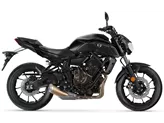Yamaha FZ-8N 2010 vs. Yamaha XJ6 2009

Yamaha FZ-8N 2010

Yamaha XJ6 2009
Overview - Yamaha FZ-8N 2010 vs Yamaha XJ6 2009
The Yamaha FZ-8N 2010 and the Yamaha XJ6 2009 are both naked bikes with similar features and specifications. However, there are some notable differences between the two models.
In terms of engine power, the Yamaha FZ-8N 2010 has a more powerful engine with 106 HP compared to the Yamaha XJ6 2009 which has 78 HP. This means that the FZ-8N will offer a more sporty and dynamic performance, making it suitable for riders who enjoy a faster and more exhilarating ride. On the other hand, the XJ6 offers a rider-friendly performance with its lower horsepower, making it more suitable for riders who prefer a more relaxed and comfortable ride.
In terms of torque, the FZ-8N has 82 Nm of torque, while the XJ6 has 59.7 Nm. This means that the FZ-8N will have better acceleration and pulling power, allowing for quicker overtakes and a more responsive ride. The XJ6, on the other hand, may feel slightly less powerful in comparison.
Both bikes have a 4-cylinder engine and liquid cooling, ensuring optimal performance and reliability. The FZ-8N has a larger displacement of 779 ccm compared to the XJ6's 600 ccm, which contributes to its higher power output.

Yamaha FZ-8N 2010
In terms of suspension, the FZ-8N features an Upside-Down telescopic fork, which provides better stability and handling, especially during aggressive riding. The XJ6, on the other hand, has a standard telescopic fork, which offers a more comfortable and smoother ride.
Both bikes have a double disk front brake system, ensuring excellent stopping power and control. The FZ-8N and XJ6 also have the same front and rear tire diameter of 17 inches, providing good grip and stability on the road.
In terms of dimensions and weights, the FZ-8N has a slightly longer wheelbase of 1460 mm compared to the XJ6's 1440 mm. This may result in slightly better stability and handling for the FZ-8N. The seat height of the FZ-8N is also slightly higher at 815 mm compared to the XJ6's 785 mm, which may be more suitable for taller riders. However, the XJ6 offers a lighter dry weight of 205 kg compared to the FZ-8N's 197 kg, which may contribute to its more playful and nimble handling.

Yamaha XJ6 2009
Both bikes have a fuel tank capacity of around 17 liters, providing a decent range for longer rides.
In terms of strengths, the FZ-8N offers a sporty engine performance with its higher horsepower and torque, making it suitable for riders who enjoy a more exhilarating ride. It also has a beefy appearance and a pleasant driving feel. The XJ6, on the other hand, offers rider-friendly performance characteristics, an optimal clutch, and playful, lighter handling. It also has a comfortable seat and a unique, aggressive look, making it appealing to younger riders. Additionally, the XJ6 is known for its high-quality build.
In terms of weaknesses, the FZ-8N's exhaust canister may not be visually appealing to some riders. The XJ6, on the other hand, may have design components that are not too demanding, and its torque development may not be as impressive as the FZ-8N.
Overall, both the Yamaha FZ-8N 2010 and the Yamaha XJ6 2009 are excellent naked bikes with their own strengths and weaknesses. The FZ-8N offers a more sporty and dynamic performance, while the XJ6 provides a more rider-friendly and comfortable experience. Ultimately, the choice between the two models will depend on the rider's preferences and riding style.
Technical Specifications Yamaha FZ-8N 2010 compared to Yamaha XJ6 2009
Pros and Cons in comparison
Pros and Cons in comparison
Yamaha FZ-8N 2010

Freely following the philosophical-optimistic view that the glass is not half empty but half full, at Yamaha you don't have to decide AGAINST two, but FOR one. In any case, the FZ8 has enough potential to become the golden mean in the circle of free-body bikes.
Yamaha XJ6 2009

Despite the common basis, the XJ appears much younger and more aggressive. A mid-cass motorbike that by no means makes you feel mid-range. Except for the swingarm, the motorbike appears quite high-quality and cool. The bike is a little easier to handle than the Diversion.
Price Comparison Avarage Market Price Yamaha FZ-8N vs Yamaha XJ6
There are a few key differences between a Yamaha FZ-8N 2010 and a Yamaha XJ6 2009. It takes less time to sell a Yamaha XJ6 with 31 days compared to 57 days for the Yamaha FZ-8N. Since model year 2010 1000PS.de editors have written 11 reviews for the Yamaha FZ-8N and 4 reviews for the Yamaha XJ6 since model year 2009. The first review for the Yamaha FZ-8N was published on 1/27/2010 and now has more than 8,200 views. This compares to more than 21,900 views for the first review on Yamaha XJ6 published on 11/13/2008.



























